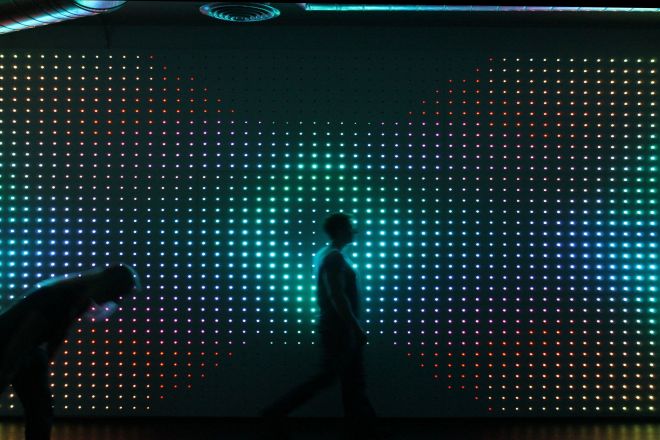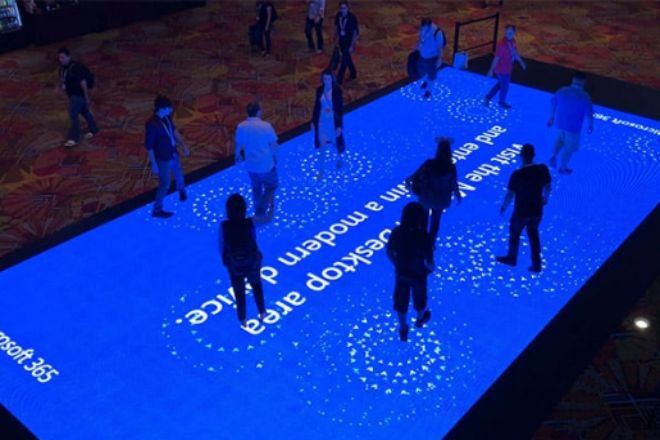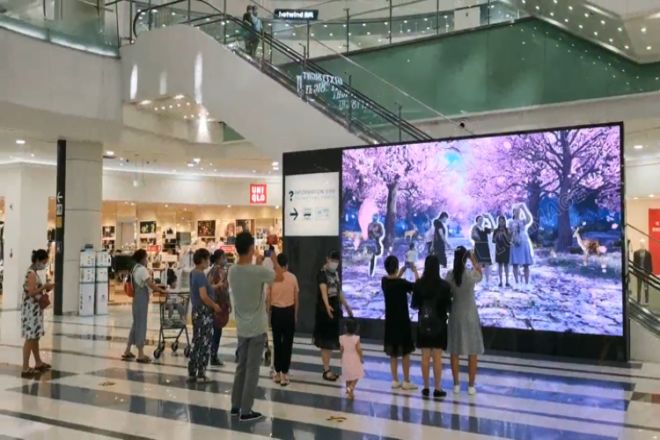序章

With the rapid development of technology, somatosensory interactive technology is gradually integrated into every aspect of our lives. Among them, the somatosensory interactive LED表示 has become a new favorite in commercial displays, theatrical performances, and other fields due to its unique interactive experience and visual impact.
Today, let us spend 3 minutes together to quickly understand the charm of somatosensory interactive LED displays.
1. What is a somatosensory interactive LED display?
The somatosensory interactive LED display is a very advanced and interesting product. It cleverly combines LED display technology and somatosensory interactive technology to bring us a new interactive experience.
First, let’s take a look at LED display technology. The LED display screen is composed of many small LED lights, which can emit bright and colorful light, allowing us to see clear and vivid images and videos. This display not only has a high resolution but also responds very quickly, updating the display content in real time.
Somatosensory interaction technology is a technology that can recognize our body movements and gestures. Through sensors installed around the display, it captures our movements in real-time and translates them into instructions that the computer can understand. In this way, we can interact with the display through simple body movements or gestures.
When these two technologies are combined, they form what we call a somatosensory interactive LED display. On this kind of display, we no longer need to use a mouse or touch screen to operate but can directly interact with body movements or gestures.
For example, we can slide our hands on the screen to browse pictures or use gestures to control the play and pause of videos. This method of interaction is not only convenient but also very intuitive, allowing us to interact with the display more naturally.
In addition to being highly interactive, the somatosensory interactive LED display also has the characteristics of dynamic display and high definition. It can update the display content in real-time as needed, allowing us to see the latest and most vivid information.
At the same time, due to its high-resolution characteristics, the display content is clear and delicate, allowing us to enjoy a more realistic visual experience.
2. Advantages of somatosensory interactive LED display

As an innovative product integrating advanced technology, the somatosensory interactive LED display screen has the advantage of providing users with unprecedented interactive experience and visual enjoyment. Its three main advantages are detailed below:
- Highly interactive:
The biggest highlight of the somatosensory interactive LED display is its powerful interactivity. Traditional display screens often can only transmit information in one direction, while somatosensory interactive LED displays can capture the user’s body movements and gestures in real-time and interact with them.
This means that users are no longer passive recipients of information but can actively participate in the display and operation of information. Whether it is a simple click, slide, or complex gesture control, it can respond in real-time, bringing users a richer and more vivid experience.
This interactivity not only enhances the user’s sense of participation and immersion but also makes the transmission of information more intuitive and efficient. In commercial displays, theatrical performances, and other occasions, the audience can interact with the display screen through body movements and participation, which increases the fun and attraction of viewing.
- Great visual impact:
The somatosensory interactive LED display uses a high-resolution LED screen, which can present clear and detailed images and videos. At the same time, its bright colors and excellent contrast also bring a strong visual impact. Combined with somatosensory interactive technology, when users operate on the screen, the screen content can change in real-time, presenting a dynamic and coherent visual effect.
This visual impact not only attracts the audience’s attention but also improves the message’s communication effect. Whether it is advertising, product display, or artistic performance, somatosensory interactive LED displays can bring shocking visual enjoyment to the audience and leave a deep impression.
- High flexibility:
The somatosensory interactive LED display is highly flexible and can be customized according to different needs and scenarios. Whether it is screen size, resolution, or interaction methods, they can be adjusted and optimized according to specific needs. This enables it to adapt to various application scenarios and meet the needs of different users.
In the commercial field, displays of different sizes and shapes can be customized according to the needs of the displayed content to better display product features and brand image. In the field of education, interactive teaching courseware can be customized to help students understand knowledge more intuitively.
In the entertainment field, various interactive games and performance scenes can be created to bring a richer entertainment experience to the audience.
3. Basic principles of somatosensory interactive LED display
The somatosensory interactive LED display is an innovative product that combines advanced somatosensory recognition technology and LED display technology. Its working principle is based on capturing and processing human body movements, postures, and other information to achieve real-time interaction with the display. Below, we will analyze its basic principles in detail:
- Somatosensory recognition system
The somatosensory recognition system is the core component of the somatosensory interactive LED display. It is mainly composed of infrared cameras, depth sensors, and other equipment that can capture and identify the movement trajectory and posture changes of the human body.
Infrared cameras can sense the position and movement of the human body by emitting infrared rays and receiving the signals reflected back. The depth sensor can measure the distance between the human body and the display screen to obtain more accurate three-dimensional information.
- Data processing and analysis
The captured human movement and posture information needs to be further processed and analyzed before it can be understood by the computer. This step is mainly completed by computer-specialized algorithms. The algorithm will process the received data in real-time, identify the key parts and movement characteristics of the human body, and convert them into instructions that the computer can understand. These instructions will be used as the basis for subsequent control of the LED display content.
- LED display response
After obtaining the processed data, the computer will control the content changes on the LED display according to these instructions. The LED display screen is composed of a large number of small LED lights. By controlling the on and off and color changes of these LED lights, rich images, and video content can be presented.
Based on the human body movement and posture information provided by the somatosensory recognition system, the computer can adjust the content on the LED display in real time to synchronize it with the audience’s movements and postures.
Through this working principle, the somatosensory interactive LED display can achieve real-time interaction with the audience, providing a richer and more immersive experience. Whether it is in commercial displays, theatrical performances, or education and training, it can play a huge role in bringing new interactive experiences and information display methods to the audience.
4. Application scenarios of somatosensory interactive LED display

As an innovative interactive display tool, the somatosensory interactive LED display has a wide range of application scenarios. Below, we will explore its applications in different fields in detail:
- Commercial display
In the commercial field, the application of somatosensory interactive LED displays is particularly prominent. In shopping malls, exhibitions, and other places, through somatosensory interactive LED displays, merchants can display product features, brand stories, and other information to attract customers’ attention.
Customers can interact with the display screen through body movements, learn detailed information about the product, and experience the use effect of the product. This interactive display method not only enhances the brand image but also increases customers’ sense of participation and purchase intention.
- Artistic performances
In the field of theatrical performances, somatosensory interactive LED displays also play an important role. In concerts, dance dramas, and other theatrical performances, the use of somatosensory interactive LED displays can create cool stage effects and enhance the audience’s sense of immersion and participation.
Actors can interact with the display screen to present a more vivid and realistic performance effect, bringing a more shocking audio-visual experience to the audience.
- Education and training
In the field of education, somatosensory interactive LED displays are also widely used. By producing interactive teaching courseware, teachers can use the display screen to display teaching content and interact with students in real-time through somatosensory interactive technology.
Students can answer questions, operate experiments, etc., through body movements to understand knowledge more intuitively and improve learning effects. This interactive teaching method not only makes the class more interesting but also improves students’ learning enthusiasm and participation.
結論
Through the above introduction, it is not difficult to find that the somatosensory interactive LED display is gradually changing the way we interact with information with its unique interactive experience and rich application scenarios.
It is not only a product of scientific and technological progress but also a manifestation of human beings’ pursuit of a better life experience.
However, although somatosensory interactive LED displays have made significant progress, we still face many challenges and opportunities. In the future, with the continuous innovation of technology and the continuous expansion of application scenarios.
最後に、LEDディスプレイについてもっと知りたい方は、 ご連絡ください。
